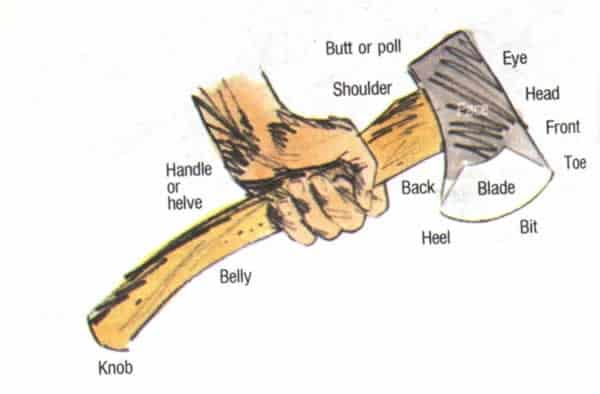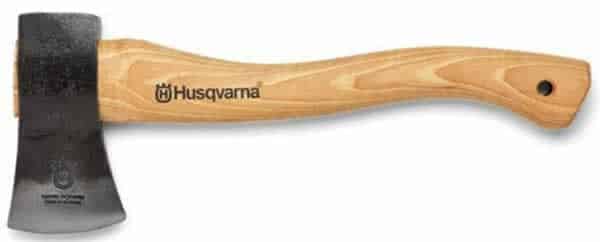Woodworking axes are among the most essential tools for every woodworker. Technology is moving forward, CNC routers and 3D printers can make almost everything that we wish for, but we are glad that, despite of that, hand crafted wood pieces are becoming more and more popular nowadays. Woodworking axes are essential in process of making every hand crafted piece of furniture and they have been unfairly neglected on our site.

Not so long ago we published an article about woodworking chisels and our readers expected us to cover woodworking axes too and here it is, our woodworking axes guide.
Parts of an ax
Before we start to cover different types of woodworking axes we must learn the basic parts of every ax. Every ax has two primary components: the head and the handle. The head of an ax is most commonly bounded by the bit/blade and the poll/butt on the other end. Some types of axes have blades on both sides without the butt. The top corner of the bit is called the toe, and the bottom corner is known as the heel. Both sides of the head are called the cheek and the hole where the haft is mounted is called the eye. The part of the bit below the rest of the ax-head is called the beard.

The handle is sometimes called the helve. The handle was always made of a resilient hardwood like hickory or ash. Modern handles are always curved for better grip and to aid in the swinging motion. The place where the head mounts onto the handle is called the shoulder. The longest part of the handle is the belly, and in the end of the handle is the knob.
Felling ax
The name itself suggests that this type of ax is used for felling trees. Felling axes always have large, heavier, around 3.3 lb, heads, longer handles, and they’re are designed for removing large chunks of wood in order to fell or take down trees.

Felling axes employ a tremendously sharp, thin blade and tapered head to be able to cut across the wood grain as deep as possible. The handle of the felling ax is quite long, around 28 to 36 inches. Felling axes can have two bits but that version is thing of the past and today the most common one is one bit felling ax.
Splitting ax
Splitting axes were initially designed for splitting logs but they are also used to split chunks of firewood into smaller, more manageable pieces. Unlike felling ax which cuts across the grain, the splitting ax is splitting wood grain. Splitting ax can be used for splitting large wood logs but we think that the best tool for that would be the splitting maul with the help of splitting wedges.

Splitting axes vary in sizes of the handle and head depending of the size of wood you need to split. Although most people still use splitting axes, you can find more and more log splitters nowadays. Small electric log splitters are very affordable and many people use them to split firewood instead of splitting it with a splitting ax.
Broad ax
The broad ax, also known as the hewing ax, is designed for hewing logs into square lumber. There are two types of cutting edge on broad axes. On one type, one side is flat and the other side beveled and on the other type, both sides are beveled. This other type is sometimes called a double bevel ax, which produces a scalloped cut. Double bevel broad axes are used for rough hewing and single bevel broad axes are used for flattening the surfaces.

On single bevel broad axes you can have left or right side beveled depending on your hand preference. For example, if you have the left side beveled then the right side is flat and leaves a flat surface on the wood.
Adze
Adze is used to rip a level surface into a horizontal piece of wood. There are two main types, foot adzes and hand adzes. The foot adzes have long handles and they are used with both hands. Flat foot adzes are used for rough wood shaving and lipped blade foot adzes are used for hollowing big pieces of wood like canoes. Hand adzes have short, one-handed blades that allow for precision carving or working in smaller spaces.

Larger one-handed adzes can be referred to as elbow adzes. Also, there is a type of adzes that is very popular among wood carvers and wood turners and that is a hollowing adze. It’s a hand adze with lipped blades that is used to hollow out bowls or for precision carving.
Hatchet
Hatchet is a small one handed ax used for chopping. Hatchets are ideal for splitting small pieces of firewood and chopping small branches from trees. Their small size allows you to squeeze into tighter spaces and requires less swings as compared to a two-handed ax.

Hatchets typically have a hammer head on the opposite side of the bit for striking purposes.
Carpenters ax
Carpenters ax or sometimes called carpenters hatchet is a small ax that is usually slightly larger than a hatchet. Carpenters ax is used in traditional woodworking, joinery and log-building.

It has a pronounced beard and finger notch to allow a choked grip for precise control. The poll is designed for use as a hammer and sometimes they have a hole in the head for pulling nails. It is probably the most common ax among woodworking axes.
Mortising ax
As the name suggests that is an ax specially designed for making mortise and tenon joints. If you don’t know what are mortise and tenon joints or you want to learn more about types of mortise and tenon joint then check out our article about Mortise and tenon joint. Mortising axes have long and thin heads which are designed for mortising. Mortising axes usually have small handles and the size of the head varies based on the size of the mortise.

In this article we covered all the main types of woodworking axes. Normally every type have many different versions which depends of the specific usage of the ax. Although there are many machines that try to replace woodworking axes, we hope that the ax will stay an essential woodworking tool.







Hi, everything is going nicely here and of course every one is sharing data, that’s genuinely good,
keep up writing.
Yes this is a great article. One thing missing though is the “Side Axe”. It was used in Britain for more accurate shaping of the external faces of a piece of timber. As an example of how giod it could be, the book “Paris to Peking” about a motor rally, describes an episode in an eastern country where the wooden wheel on a vintage car collapses and a carpenter using his side axe makes a new wheel – which sees them all the way to Peking!
Very interesting article , it gets you thinking. I really liked the different axes for jobs . Think I might look into it a little more . Thanks again .